Research Brief: Impacts of Sources and Forms of Nitrogen on Harmful Algal Blooms in Lake Erie
4Eutrophication of lakes across the world has also led to harmful algal blooms everywhere, as rivers and lakes are exposed to nutrient-rich waters carrying nitrogen and phosphorus. Some of the most frequently studied blooms are those that occur annually in Lake Erie. The western basin is known to be particularly impacted by cyanobacterial blooms, primarily as a result of excess anthropogenic inputs of nitrogen and phosphorous that enter the basin via the Maumee River.
These blooms are dominated by Microcystis, a non-nitrogen fixing cyanobacteria— meaning that the bacteria cannot pull nitrogen from the atmosphere like other vegetation but instead consumes various nitrogen species that enter the lake as runoff from the Maumee River.
Previous studies have historically focused on nitrate because it is the most abundant nitrogen substrate during bloom initiation, but recent studies have found that substrates like ammonium and dissolved organic nitrogen promote a larger bloom.
A 2023 study published in Limnology and Oceanography measured concentrations and natural abundance δ15N isotope values of dissolved nitrogen substrates and phytoplankton biomass. The research focuses on examining the significance of oxidized and reduced nitrogen substrate to phytoplankton during different bloom stages.1
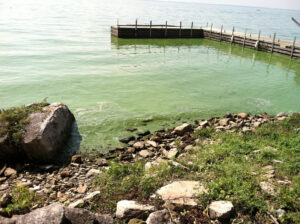
Algal bloom in Lake Erie, Kelley’s Island. October 16, 2011. (Credit: T. Joyce / NOAA via Flickr Public Domain)
Methods
Samples were collected from three sites throughout the western basin of Lake Erie during the 2020 algal bloom. Sampling occurred on an approximately weekly basis starting in mid-June and ending in late September. The stations form a transect extending offshore and correspond to NOAA Great Lakes Environmental Research Laboratory long-term monitoring stations. The three stations were WE9 (Maumee Bay), WE2 (Nearshore) and WE4 (Offshore). These sites were chosen in order to capture a variety of water depths and proximity to the Maumee River.
After collecting samples, the phytoplankton community was assessed using a submersible fluoroprobe which monitors in situ chlorophyll fluorescence. The fluoroprobe also quantifies four broad groups of chlorophyll a-containing phytoplankton: green algae, cyanobacteria, diatoms and cryptophytes.
Dissolved nutrient and microcystin concentrations were conducted at the Cooperative Institute for Great Lakes Research at the University of Michigan. δ15N values of NO3– and total dissolved nitrogen (which includes NO3-, NO2-, NH4+ and dissolved organic nitrogen) were measured using the denitrifier method.
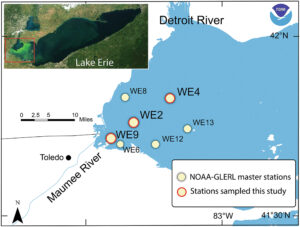
NOAA-GLERL master stations in Lake Erie and selected stations monitored during this study. Water column depths are 2.7, 5.7, and 8.9 m for WE9, WE2, and WE4, respectively. (Credit: Kharbush et al., 2023)
Results
Results of the various analyses suggest that NO3– was a greater contributor to phytoplankton biomass than dissolved organic nitrogen and that riverine input was the primary influence on NO3– δ15N values in Western Lake Erie, with little effect from biological processes.1
Furthermore, “toxin concentrations were positively correlated with δ15N values of particulate organic matter and NO3-, suggesting that toxin-producing cyanobacteria relied on isotopically heavier N substrates sourced from the Maumee River.”1
Results support previous research that highlight the importance of regenerated nitrogen in the longevity of cyanobacterial blooms. Patterns identified in the study are a starting point for future research focusing on how external and internal nitrogen sources fuel blooms in Western Lake Erie.
Source
- Kharbush, J.J., Robinson, R.S. and Carter, S.J. (2023), Patterns in sources and forms of nitrogen in a large eutrophic lake during a cyanobacterial harmful algal bloom. Limnol Oceanogr, 68: 803-815. https://doi.org/10.1002/lno.12311




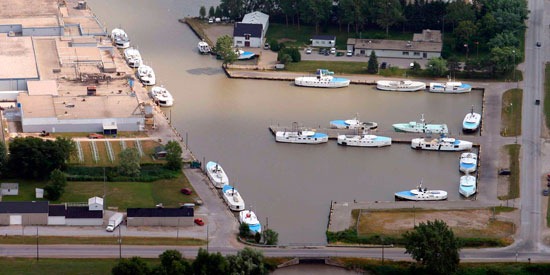
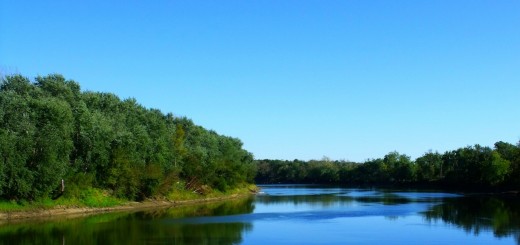
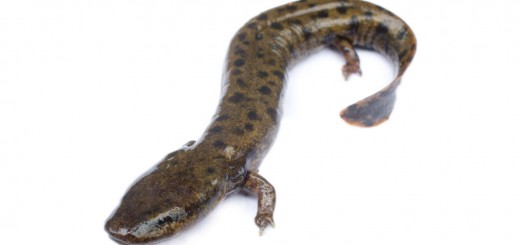
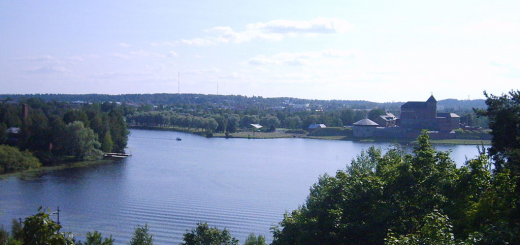






[…] HABs can be predicted through nutrient loading, this strategy has been found to be less accurate in extreme bloom years.1 A 2022 study published […]
[…] and subsequent harmful algal blooms in large freshwater lakes like Lake Erie occur annually as a result of nutrient pollution from runoff as well as nutrient loading […]
[…] for two reasons. First was data availability due to the local and federal interest in monitoring recurring cyanobacterial blooms, leading to annual deployments of environmental monitoring buoys. Second, Lake Erie represents a […]
[…] Research Brief: Impacts of Sources and Forms of Nitrogen on Harmful Algal Blooms in Lake Erie […]